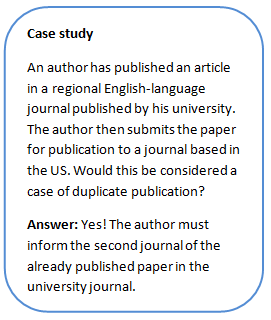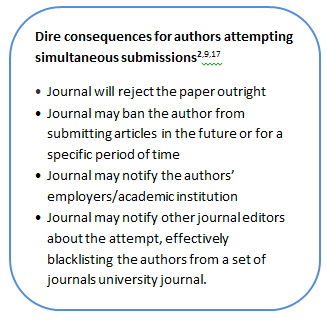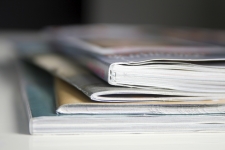Introduction
Ethical research and publication practices are essential for honest scholarly and scientific research. Most journals today are keenly aware of this: they publish policies1-6 on these issues and expect authors to “be aware of, and comply with, best practice in publication ethics”5.This article discusses two widespread and related publishing practices that are considered unethical—duplicate publication and simultaneous submission. It draws on definitive international publication ethics guidelines.7-10

Duplicate publication
Duplicate (or redundant) publication is the publication of a paper that is substantially similar to a published paper by the same author, without acknowledging the source and without obtaining the permission of the original copyright holder.7,11,12 There may be superfluous differences between the original and the second paper, such as a new title or a modified abstract, but the data set and findings stay the same.13
Why is duplicate publication a problem?
Republication of a paper without permission and/or acknowledgment is a serious breach of publishing ethics, for the following reasons:.
- It violates copyright as in most cases, the copyright for the paper lies with the journal and not with the authors; thus, the authors are not free to republish the paper.11,12
- It could distort empirical evidence because researchers studying the subject may erroneously count the same set of results twice (because the results are presented in two separate papers).7As empirical studies form the basis for policies and other medical/scientific decisions, this is a serious problem.13
- It amounts to “self-plagiarism,” because it involves the use material from another work, without attribution.14
- It leads to a waste of editorial and review resources.7,13
- It denies other authors the chance to publish their work by unjustly taking up limited/competitive journal space.13
- It is a “sign of poor scholarship”12 and may indicate that the “study contributes only marginally to the literature.”9
What do journals and ethical guidelines have to say about the issue?
Ethical and editorial committees7-9, 15,16and academic journals 1-3,5,6,17 explicitly instruct authors not to submit papers or variations of papers on studies that have already been published elsewhere. Several journals have stringent policies that require authors to send copies of older, related articles along with the submitted paper2,3,12 if the study findings and subjects overlap. Some journals are very specific and require that this be done when the overlap is more than a certain percent.2 Others permit only a few identical sentences; previously published results or larger portions of text taken verbatim from the author’s older publications, without acknowledgment, are not accepted.17
However, republication is permitted1,7,8 in the case of specific article types. These are:
- A complete paper, that follows up on a published preliminary report (e.g., an abstract, poster, or conference presentation)
- A paper listing guidelines prepared by professional societies or governmental agencies, which need to be disseminated to a wide and varied readership
- A paper that substantially re-analyses the study findings or re-interpretsthe results for a different audience
- A translation of the original paper
- In some fields like physics, authors are allowed to post their papers in e-print repositories (notably, at arXiv.org)

While these exceptions can be made, authors must adhere to the following guidelines7,8 in these cases as well:
- Obtain permission from the copyright holders.
- Get approval from the editor of the journal in which the paper was first published and the editor of the journal in which it will be republished.
- Acknowledge that the paper has been republished in whole or is based on a previously published paperand provide the full citation for the primary publication.
Dos and don’ts for authors7,15
- Do not replicate content from any of your other published papers.
- Do not offer preliminary reports about unpublished papers to the media, companies, or other agencies, without the permission of the journal.
- When quoting material from your previously published work, do not include more than a few sentences from the older work. Also, place the text in quotation marks and cite the source
- When using a single dataset to write more than one manuscript, ensure that
- each manuscript addresses separate and important questions
- the manuscripts are cross-referenced
- you inform the journal editors about this matter in a cover letter
- If you have published related papers, provide details of these papers to the journal editor at the time of submission. Include copies of these papers with the submitted manuscript. This will ensure full transparency and will help the editor make the right decision.
Simultaneous submission
Simultaneous submission refers to the “practice of submitting the same manuscript to two or more journals at the same time”1without informing the journal editor that the manuscript has been submitted elsewhere. It has also been termed multiple submissions or dual submission. While duplicate publication involves the submission of a previously published manuscript to another journal, simultaneous submission involves the submission of a manuscript that is under consideration at another journal.
Why is simultaneous submission a problem?
Although some researchers argue that this practice is not dishonest and is merely a way to counter the long-drawn-out journal publication process,18 journals consider it to be “unethical publishing behavior”1 for the following reasons:7,9
- A copyright violation or a copyright dispute could ensue, if more than one journal decides to publish the paper.
- It leads to a waste of academic and scientific resources as two (or more) journals would spend time and money on carrying out the same production tasks.
However, in some exceptional cases, multiple submissions may be allowed, provided the authors have notified editors of all the journals involved about the concurrent submission. These exceptions are listed below:
- When the editors of the 2 (or more) journals agree to simultaneously or jointly publish the paper, because doing so is in the best interest of society at large.7,15
- When scholarly or scientific conferences explicitly authorize authors to simultaneously submit papers to other meetings with overlapping submission periods.19
Dos and don’ts for authors 3,9,15
- Do not submit the same manuscript to more than one journal.
- If you wish to submit a paper that is “under consideration” at one journal, to another journal:
- Get written consent from your co-authors.
- Write to the first journal editor about this, asking that the paper be withdrawn.
- Get a formal notification from the first journal editor that has been withdrawn from consideration.
- Preserve this notification and present it to the second journal at the time of submission.
- If you have written 2 related papers and wish to submit them to 2 different journals:
- Disclose the details of each paper to both journals.
- Inform the editors that you have a similar paper under review at another journal (even if these papers are written in different languages).
- Enclose copies of these papers along with your submission.
Conclusion
Authors must be careful not to attempt duplicate publication and simultaneous submission. Apart from the fact that these practices are serious violations of copyright laws and that they can dent the integrity of scientific literature, they are also viewed as “violations of authorial integrity”17 and can reflect poorly on an author’s honesty and scholarly abilities. We recommend, therefore, that authors study the resources listed in the reference list below and read through relevant case studies20 so that they are able to understand and follow ethical submission practices.
1. Elsevier.Ethical Guidelines for Journal Publication.[Accessed: Aug 10, 2011] Available from: http://www.elsevier.com/wps/find/intro.cws_home/ethical_guidelines.
2. BMJ Publishing Group. Scientific Misconduct. [Accessed: Aug 10, 2011] Available from: http://resources.bmj.com/bmj/authors/editorial-policies/scientific-misconduct.
3. Nature Publishing Group. Guide to Publication Policies of the Nature Journals. [Accessed: Aug 10, 2011] Available from: http://www.nature.com/authors/policies/publication.html.
4. Sage Publications. Ethics and Responsibility. [Accessed: Aug 10, 2011] Available from: http://www.sagepub.com/journalgateway/ethics.htm.
5. PloS.org. PLoS Editorial and Publishing Policies.[Accessed: Aug 10, 2011] Available from: http://www.plosone.org/static/policies.action.
6. ACS Publications.Ethical Guidelines to Publication of Chemical Research.[Accessed: Aug 10, 2011] Available from: http://pubs.acs.org/userimages/ContentEditor/1218054468605/ethics.pdf.
7. International Committee of Medical Journal Editors. Uniform Requirements for Manuscripts Submitted to Biomedical Journals: Writing and Editing for Biomedical Publications.[Accessed: Aug 10, 2011] Available from: http://www.icmje.org/urm_full.pdf.
8. The International Society for Medical Publication Professionals.Good Publication Practice for Communicating Company Sponsored Medical Research: The GPP2 Guidelines.[Accessed: Aug 10, 2011] Available from: http://gpp-guidelines.org/GPP2.pdf.
9. Council of Science Editors.CSE's White Paper on Promoting Integrity in Scientific Journal Publications, 2009 Update.[Accessed: Aug 10, 2011] Available from: www.councilscienceed-itors.org/files/public/entire_whitepaper.pdf.
10. Committee on Publication Ethics.Code of Conduct for Journal Editors. [Accessed: Aug 10, 2011] Available from: http://publicationethics.org/files/Code_of_conduct_for_journal_editors_Mar11.pdf.
11. Morse JM, 2007. Duplicate Publication. Qualitative Health Research, 17(10): 1307–1308.
12. Society for Industrial and Applied Mathematics. Plagiarism, Duplicate Publication, and Other Suspected Author, Editor, or Referee Misconduct. [Accessed: Aug 10, 2011] Available from: http://www.siam.org/journals/plagiary/Plagiarism_guidelines_Mar2011.pdf.
13. Roig M. Avoiding Plagiarism, Self-plagiarism, and Other Questionable Writing Practices: A Guide to Ethical Writing. [Accessed: Aug 10, 2011] Available from: http://www.cse.msu.edu/~alexliu/plagiarism.pdf
14. Editorial, 2009:Combating Plagiarism. Nature Photonics, 3; 237. [Accessed: Aug 10, 2011] Available from: http://www.nature.com/nphoton/journal/v3/n5/full/nphoton.2009.48.html.
15. World Association of Medical Editors. Publication Ethics Policies for Medical Journals. [Accessed: Aug 10, 2011] Available from: http://www.wame.org/resources/publication-ethics-policies-for-medical-journals.
16. Committee on Publication Ethics. What to Do If You Suspect Redundant (Duplicate) Publication. [Accessed: Aug 10, 2011] Available from: http://publicationethics.org/files/u2/01B_Redundant_Published.pdf and http://publicationethics.org/files/u2/01A_Redundant_Submitted.pdf.
17. Society for Industrial and Applied Mathematics. Authorial Integrity in Scientific Publication. [Accessed: Aug 10, 2011] Available from: http://www.siam.org/journals/plagiarism.php.
18. Torgerson DJ, Adamson J, Cockayne S, Dumville Jo, Petherick E, 2005. Submission to Multiple Journals: A Method of Reducing Time to Publication? British Medical Journal, 330(7486):305–307.
19. Association for Computing Machinery. Policy on Prior Publication and Simultaneous Submissions. [Accessed: Aug 10, 2011] Available from: http://www.acm.org/publications/policies/sim_submissions/.
20. Elsevier. Decision Trees: Multiple, Duplicate, Concurrent Publication/Simultaneous Submission. [Accessed: Aug 10, 2011] Available from: http://www.elsevier.com/wps/find/editorshome.editors/3_Multiple_publication.











